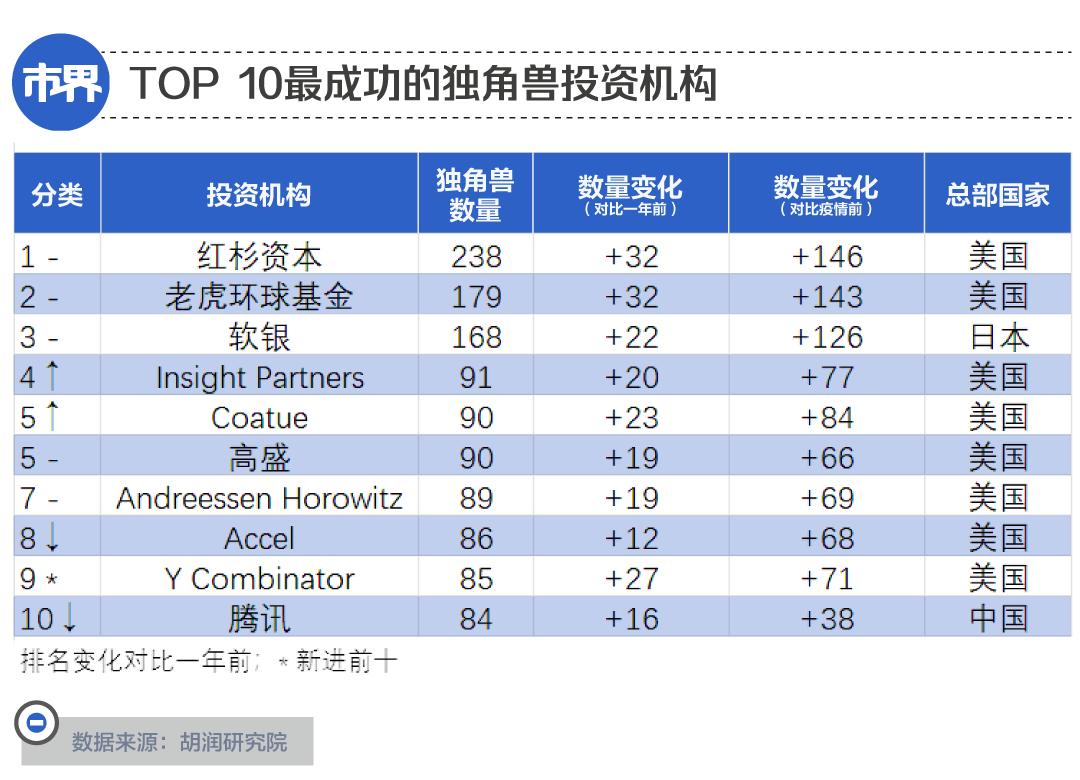
As one of the largest VC (venture capital institutions) in the world, Sequoia Capital will be "divided into three parts" in the future.
On the evening of June 6th, official micro of Sequoia China released a letter to the founders of Sequoia China member enterprises, announcing that Sequoia Capital will split its local funds in the United States, Europe, China and India/Southeast Asia, and conduct their own completely independent operations, which will be completed before March 31st, 2024.
Sequoia Capital was born in the United States in 1972. By investing in more than 1,000 enterprises with distinctive technical characteristics, high growth and high development potential, it has become an investment institution with the influence of the industry vane, and is called "the entrepreneur behind the entrepreneur". By 2022, the company managed assets of about $85 billion, or about 606 billion yuan.
In the list of global unicorns released by Hurun in 2023, Sequoia Capital has once again become the most successful unicorn investment institution in the world by investing in 238 unicorn enterprises, and is far ahead of well-known institutions such as Tiger Global Fund and Softbank. It is precisely because of its great influence that the spin-off of Sequoia Capital has also caused a lot of heated discussion in the investment community.

In fact, this spin-off is not an emergency, but a long-simmering business restructuring of Sequoia Capital. As Shen Nanpeng, the main partner of Sequoia Capital and the founder of Sequoia China, told the media, "Now the similarities between different entities of Sequoia are much less, and discussions on the split business have been going on for the past two or three years."
After the split, Sequoia Capital’s original three major sectors will not only have their names adjusted, but also the focus of investment will be quite different.
Among them, Sequoia USA and Europe will continue to use the brand of Sequoia Capital, Sequoia China will continue to use the Chinese brand name of Sequoia, but it will use "HongShan" as its English name, and Sequoia India/Southeast Asia will be renamed as "Peak XV Partners". A person familiar with the matter told CNBC, "Sequoia China has diversified its investment strategy into multiple funds, while Sequoia’s US and European businesses have been reorganized to focus on Sequoia Capital Fund. Sequoia India/Southeast Asia is highly focused on the excavation and cultivation of early founders. "
As for the reasons for the split, Sequoia’s explanation is that the deeper localization of each region makes the global centralized operation mode of some back-office functions gradually become a burden. With the internationalization of investment enterprises in different regions of Sequoia and the global competition, competition will inevitably occur, while Sequoia shares the same brand in all regions, which will bring troubles to the founders and member enterprises.

As for why it split up at this time, it may be related to the rapid growth of Sequoia China. Although Sequoia China has brought rich economic returns to Sequoia Capital in recent years, the distribution of benefits has become increasingly prominent. After splitting up, Sequoia China will no longer share profits with Sequoia Europe and the United States.
Sequoia revealed in the letter that after 18 years of development, Sequoia China’s investment direction is more extensive and diversified. Thanks to the opportunity of China market, Sequoia China set up a new infrastructure fund to invest in the infrastructure of China’s new economic industry, and in recent years, it developed M&A investment. These unique businesses of Sequoia China have enabled it to break through the definition of traditional venture capital and become an investment institution with diversified business.
According to Forbes’ report in May, Sequoia China holds 10% of ByteDance’s shares, and the potential value of this investment alone is as high as tens of billions of dollars. In addition, the nearly 200-fold floating profit from previous investment in the US Mission and public comments has made Sequoia China earn a lot of money. According to the Securities Times, Sequoia China has managed over 300 billion yuan and invested in more than 900 projects.
On the other hand, after Roelof Botha took over the top management of Sequoia USA, the "Sequoia Fund" launched was hit hard by the US stock market, and its performance was not satisfactory. Then in March of this year, the sudden "death" of Silicon Valley Bank made Sequoia America, as its big customer, also experience a test.
In fact, under the leadership of Shen Nanpeng, Sequoia China already has a localized investment and management model, and has formed a unique system of Sequoia China in terms of business model and concept, so it needs independent operation to play a greater advantage. Coupled with the domestic fund-raising environment, state-owned funds are becoming an increasingly important source of LP. Abandoning Sequoia China as a foreign capital based on the basic situation of China will also be more conducive to its future development.
Shen Nanpeng, the head of Sequoia China, is a "genius" in the investment field.
Shen Nanpeng, born in Haining, Zhejiang Province in 1967, worked in Citibank, Lehman Brothers Asia and Deutsche Bank China after obtaining a master’s degree from Yale University. Later, he co-founded Ctrip.com and Home Inn, and both companies landed on Nasdaq in only four years. In 2005, Shen Nanpeng founded Sequoia China, and continues to write the legend of making wealth.
In Forbes’ list of the world’s best venture capitalists in 2023 released not long ago, Shen Nanpeng topped the list for the fourth time with his investment in Meituan, Pinduoduo and ByteDance, which is also his 12th time on the list and his fourth time winning. Previously, Shen Nanpeng had been the best venture capitalist for three consecutive years (2018-2020), and was also the highest ranked Chinese investor for nine consecutive years since he was listed in 2012.
Sequoia China official website shows that besides investing in the giants of their respective tracks mentioned above, there are also well-known enterprises such as Alibaba, JD.COM, Debon Logistics, noah wealth, DJI Innovation, BYD, Weilai, Gaode, Aauto Quicker, Huolala, Vipshop, Huada Gene, Jumeiyoupin, Qihoo 360 and ZTO Express.
In fact, an important factor for the success of Shen Nanpeng and Sequoia China comes from the strategy of "investing early and investing small". Through the forward-looking judgment of industry trends, we choose the fields with the most promising investment opportunities and make an early layout, instead of spending a lot of money on strategic investment later. According to statistics, Sequoia China invested more than half of all fields before the A round (including the A round).
Moreover, Sequoia China’s investment logic has experienced a gradual change in three stages: the whole track-the key track-the subdivision track in the key track. By dividing the broad investment fields more finely, it can help it to judge the next round of enthusiasm more accurately in advance. In addition, paying attention to post-investment management also enables Sequoia China to find risks in time, grow together with the invested enterprises, and give follow-up strategic guidance, so as to maximize profits.

Through observation, it is not difficult to find that, in addition to science and technology industry, Sequoia China’s main investment fields include medical and health care and traditional consumption tracks. With the continuous emergence of new tracks, Sequoia China has also begun to exert its strength in these new fields. In a previous public speech, Shen Nanpeng revealed that "in recent years, hard technology projects such as artificial intelligence and high-end manufacturing have exceeded 80% of Sequoia China’s portfolio".
According to Zhou Kui, a partner of Sequoia China, Sequoia China will capture new trends along three frameworks in the future, namely, low carbon, cloud/end structure evolution and industrial digitalization.
Zhou Kui explained, "Traditional energy is resource-driven, new energy is innovation-driven, and all aspects of power generation, energy storage and application are improving efficiency through science and technology, so we will pay attention to the release of existing industrial capabilities and innovation and progress of new energy. As for the evolution of the cloud/end structure, although there have been various ups and downs and great changes in the world, the pace of technological progress and industrial development of the communication revolution has not stopped. We have seen opportunities for core software and chips, as well as the original information industry institutions. Gradually restructuring. "
关于作者